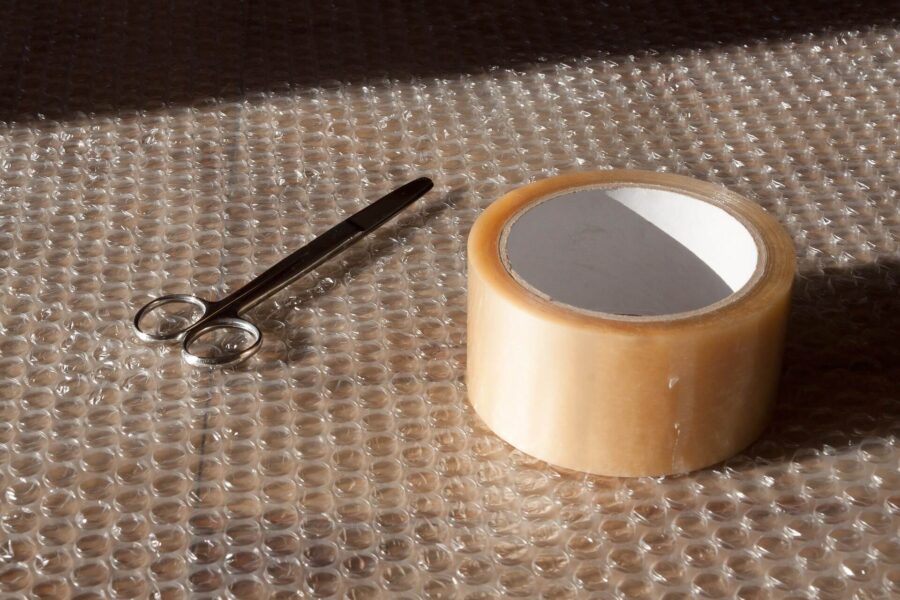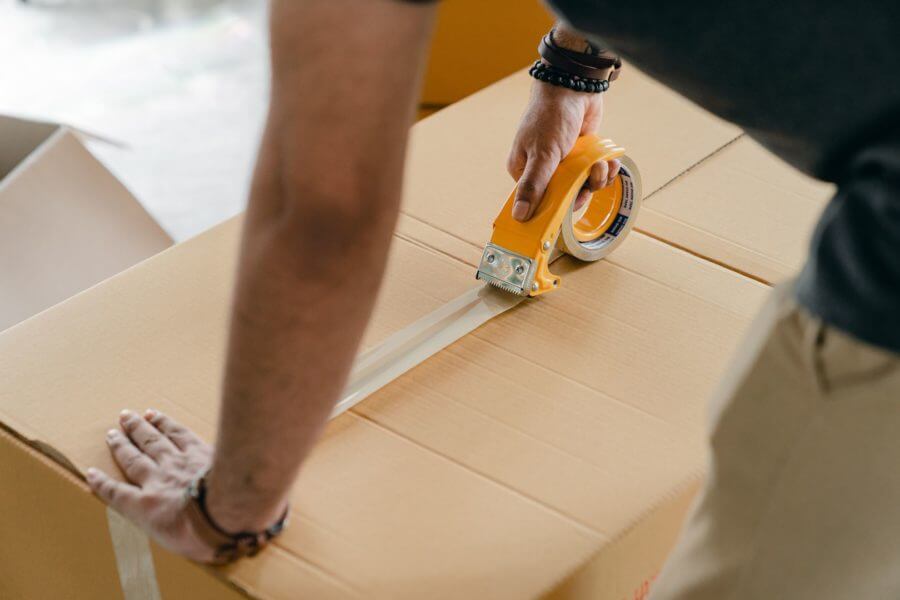

Artful Packing – How to Pack Pictures for Moving Without Damage
Posted in How-to,Moving Tips & Tricks on December 5, 2023
Moving cross country can be a complicated task, especially when it comes to safeguarding precious photographs. Whether you have a collection of valuable pictures, family portraits, or sentimental pieces, knowing how to pack pictures for moving and ensuring their safe transit is crucial. In this guide, we’ll explore the techniques and tips on how to pack pictures for a move so they arrive at a new home unscathed and ready to grace your walls once again.
How to Pack Pictures for Moving
When it comes to packing pictures for moving, gather sturdy cardboard moving boxes, bubble wrap, packing tape, and packing paper. Remove frames and glass to reduce the risk of breakage, then wrap each piece in acid-free paper and add an extra layer of protection with bubble wrap. For framed pieces, use custom-sized or adjustable picture boxes for a snug fit. Fill any gaps with packaging paper to prevent shifting. Label boxes clearly as fragile and indicate their orientation. When loading onto the moving truck, place them vertically and secure them to minimize jostling.
Know Your Collection – Assessing and Categorizing Pictures
Before you embark on the packing process, it’s crucial to get to know your collection intimately. Each piece may vary in terms of fragility and value, demanding a customized approach to ensure a safe move. To begin, consider the type of pictures you have, as they may require different handling and protection.
Additionally, assess the materials used and the overall condition of each piece. This evaluation will allow you to make informed decisions about the packing materials and techniques you’ll need to employ to keep precious art in pristine condition throughout the moving process. Not all pictures are created equal when it comes to fragility and value. To protect the collection effectively, it’s essential to understand these differences and take appropriate measures.
Paintings on canvas, for instance, can be vulnerable to punctures and tears, so they should be handled with extra care. Valuable, irreplaceable pieces should be given the utmost attention, including custom packaging if necessary. Delicate prints may require additional layers of protection to prevent creasing or bending. By assessing the fragility and value of your picture collection, you’ll be better equipped to prioritize packaging efforts and ensure each piece arrives safely.
Advice on Categorizing Pictures for Packing
Categorizing pictures based on their size, fragility, and value is a strategic approach to streamline the packing process and minimize the risk of damage during the relocation. Begin by separating small and large pictures, as their packing requirements will differ significantly. Valuable or sentimental pieces should be grouped together for specialized handling and additional protection. Framed photographs and delicate prints can be categorized separately, as they may need similar packing methods.

Packing Supplies Checklist – Everything You Need
An efficient relocation begins with having the right tools at your disposal, and when it comes to packing, having the appropriate supplies is paramount. Packaging materials play a crucial role in ensuring the safe transit of your belongings, including fragile items like pictures. To help you get organized, here’s a comprehensive checklist of packaging materials you’ll need:
- Bubble wrap – This is your go-to for cushioning delicate items, providing a protective barrier against shocks and impacts.
- Packaging paper – Ideal for wrapping and padding, packaging paper prevents scratches and provides an extra layer of protection.
- Corner protectors – These small but essential items safeguard the vulnerable corners of framed pictures, preventing damage during handling and transport.
- Sturdy boxes – Ensure you have an ample supply of sturdy cardboard boxes in various sizes to accommodate pictures. Adjustable picture boxes are ideal for framed pieces, while standard boxes work for smaller items and unframed ones.
Pre-Packing Prep – Cleaning and Protecting Each Picture
Before you embark on the packing process for pictures, it’s essential to prepare them properly. Start by cleaning each picture meticulously. Use a soft, lint-free cloth to gently remove dust and dirt from the surface. Be cautious when cleaning framed pieces, paying particular attention to the glass or acrylic covering, which can be easily scratched. If a picture has loose parts, like hanging wires or hooks, secure them or remove them temporarily to prevent damage during transit.
Additionally, consider the environmental factors that can affect items during the move. Protect pictures from moisture and dust by placing them in a climate-controlled area before packaging. Avoid storing them in damp or excessively dry conditions, as extreme humidity levels can lead to warping or mold growth.
Wrap Like a Pro – Safeguarding Pictures
When it comes to how to pack large pictures for moving, proper wrapping is the key to ensuring their safety during transportation. If you’re wondering how to wrap pictures for moving like a pro, follow this step-by-step guide that accommodates different sizes and shapes.
Begin by laying a clean, flat surface and place a picture face down on acid-free packaging paper. Start wrapping from one corner, folding the paper over the back and then the opposite corner, creating a snug envelope. Secure the paper in place with tape, paying extra attention to the corners.
The key to how to pack picture frames for moving is to add an additional layer of protection with bubble wrap, focusing on the glass and frame edges, which are vulnerable to damage. Ensure the wrap is secure but not too tight to avoid putting pressure on the picture. By following these techniques, you’ll safeguard pictures effectively and give them the best chance of arriving at your new home unscathed.

Box Selection – Finding the Perfect Fit for Your Pictures
Selecting the right boxes is a critical step in ensuring their safe transport during a relocation. Different types of pictures may require different box sizes and types. For smaller and unframed pieces, consider using standard cardboard boxes with appropriate dimensions.
For larger framed pieces, it’s advisable to invest in adjustable picture boxes that can be customized to fit the specific dimensions of each piece. These boxes provide extra protection and support, reducing the risk of shifting during transit. When choosing boxes, keep in mind the pictures’ fragility and value, opting for thicker and sturdier boxes for valuable or delicate pieces. By matching the box to the pictures’ size and nature, you’ll set the foundation for a successful packaging process.
How to Reinforce and Prepare Boxes for Packing
To ensure that chosen boxes are up to the task of protecting pictures during the relocation, it’s essential to reinforce and prepare them adequately. Start by reinforcing the bottom of each box with packaging tape, creating a strong foundation that can support the weight of the picture collection.
Add extra layers of tape along the seams for added security. Consider adding cushioning material at the bottom of the box, such as crumpled packaging paper or foam sheets, to provide a protective buffer. Additionally, label each box clearly, indicating the fragile contents and their orientation.

Packing Strategy – Securely Placing Pictures in Boxes
Efficient packing of pictures entails a strategic approach to ensure their safety during the relocation. Begin by arranging each picture inside the chosen boxes with precision, stacking smaller pieces with protective layers in between, and positioning framed pieces vertically to avoid stacking. Fill any voids around the pictures with packaging materials to minimize movement during transit.
Extra care should be taken to create a snug, secure fit within the box, reducing the risk of contact between pieces.
Additionally, use foam sheets, packaging paper, or bubble wrap to cushion empty spaces and act as shock absorbers, preventing shifting and potential damage.
This meticulous packaging strategy will go a long way in preserving pictures during the process of long-distance moving.
Labeling and Handling
Labeling boxes correctly is a crucial aspect of the packaging process, especially when it comes to pictures and fragile items. Clearly mark each box with the word “Fragile” and indicate the orientation of the contents, such as “This Side Up.” Use a permanent marker to make these moving labels easily visible. When handling the boxes, be gentle and mindful of their fragile contents.
Avoid placing heavy items on top of boxes containing pictures, and store them in an upright position during transit. When you arrive at the new home, unpack all pieces with care, inspecting them for any damage that may have occurred during the relocation. Proper labeling and careful handling are the final steps in ensuring that the collection arrives at its destination in the same condition it left.

Hire Professional Movers to Ensure a Safe Move of Your Picture Collection
When it comes to the safe transportation of valuable collections, hiring professional long-distance movers can be a wise investment. Experienced moving companies have the expertise and equipment necessary to handle fragile and valuable items with care. They know the best way to pack picture frames and understand the nuances of packing services, loading, and securing each picture and frame for transport, minimizing the risk of damage or relocation mistakes during transit.
Moreover, professional movers often offer specialized services for art and picture handling, including custom crating and climate-controlled transportation, ensuring that your collection makes the journey in the best possible condition. While cross-country moving services may come with a cost, the peace of mind and assurance of a safe relocation for your picture collection can be well worth it when entrusting this delicate task to skilled professionals.

Ensuring the Safety of Artwork is Easy With Cross Country Movers
In conclusion, the safety of your picture collection during a move hinges on meticulous packing and thoughtful handling. Approach this process with the utmost care and attention, as the collection holds not only monetary value but also sentimental significance. If you want to have peace of mind knowing that your cherished pictures will arrive safely, contact us and allow Cross Country Movers to take care of it. Your collection deserves the best, and we’re here to deliver it.
FAQ
How Can I Protect Large Framed Pictures During a Move?
To protect large framed pictures, use adjustable picture boxes for a snug fit and extra support. Wrap them in bubble wrap, securing the glass or frame edges, and consider adding corner protectors for additional reinforcement.
What Is the Best Way to Pack Multiple Small Pictures?
The best way to pack multiple small pictures is to stack them with layers of protective packaging paper or bubble wrap between each piece. Place them snugly in a sturdy cardboard box, cushioning empty spaces to prevent movement.
Is It Necessary to Use Glassine Paper for Packing Pictures?
While not strictly necessary, using glassine paper is a good practice for added protection, as it prevents sticking or smudging between the picture and packaging materials, especially for delicate pieces.
Can I Stack Framed Pictures in One Box?
Avoid stacking framed pictures directly on top of each other, as it increases the risk of damage. Instead, position them vertically in the box to prevent contact between frames.
Should I Insure My Valuable Pieces for the Move?
Yes, it’s advisable to insure all valuable pieces for the move. Most moving companies offer insurance options, or you can explore specialized art insurance policies to ensure adequate coverage.
How Do I Unpack and Assess the Condition of Pictures Post-Move?
During the unpacking process, handle pictures with care and inspect them for any damage. Look for scratches, cracks, or frame issues. Document any issues for insurance claims, if necessary.
What to Do If a Picture Frame or Glass Breaks During the Move?
If a picture frame or glass breaks during the move, carefully remove the broken glass, secure the artwork, and assess the damage. Take photos and contact an insurance provider or a professional art restorer if needed.






